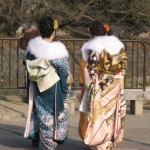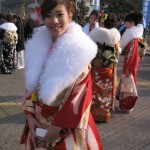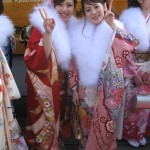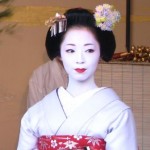From Ian Ropke,
This month visitors will have a great chance to photograph children all dressed up in kimono, a special opportunity not to be missed. November is the month of the shichi-go-san (7-5-3) ritual for girls (seven and three years of age) and boys (five years of age).

Shichi-Go-San is believed to have started in the Heian Period (794-1185). It was a ritual developed by court nobles to celebrate the passage of their children into middle childhood. In Japanese numerology, odd numbers are considered to be lucky.
In the Kamakura period (1185-1333), the fifteenth of what is now known as November was set as the date for this ceremony.
The samurai class also found the ritual beneficial for their children. Samurai children, according to the custom of the warrior class, had their heads shaven until they were three years old. Samurai boys were allowed to wear their first hakama (samurai formal wear) at age five. And samurai girls from age seven onwards were allowed to wear obi sashes around their kimono instead of simple cords.
By the Meiji period (1868-1912), the shichi-go-san tradition was firmly part of the annual traditional practices observed by all classes. By this time, the practice also included visiting a shrine to have the local deities keep the children free of bad spirits and to bless them with a long, healthy life.
Today, the tradition has changed little. Three-year-old girls and five-year-old boys often wear their first formal Japanese clothing, kimono for girls and hakama for boys, at a shichi-go-san ceremony. Three-year-old girls differ from the seven-year-olds in that they usually wear hifu padded vest over their kimono.
Chitoseame or “thousand year candy” is something that children also look forward to in November, as part of the shichi-go-san ritual. These long, thin candies, presented bags decorated with a crane and a turtle, symbols of longevity, are colored red and white (the colors of celebration in Japan). Eating the candy is said to ensure a child’s healthy growth and a long life.
The best shrines in Kyoto to see this beautiful and colorful ceremony are Heian Shrine, Shimogamo Shrine, and Kamigamo Shrine. Though the 15th is still considered the actual correct day of the event, modern times have resulted in both weekends before and after the 15th as being the most popular. This month, the 14th and 15th and the 21st and 22nd will be the best time to experience shichi-go-san and take some of the cutest and most memorable pictures you will ever see.
Text and image by Ian Ropke. Ian Ropke is the author of the Historical Dictionary of Osaka and Kyoto, and director of Your Japan Private Tours. You can read his previous articles for Deep Kyoto here.

































































